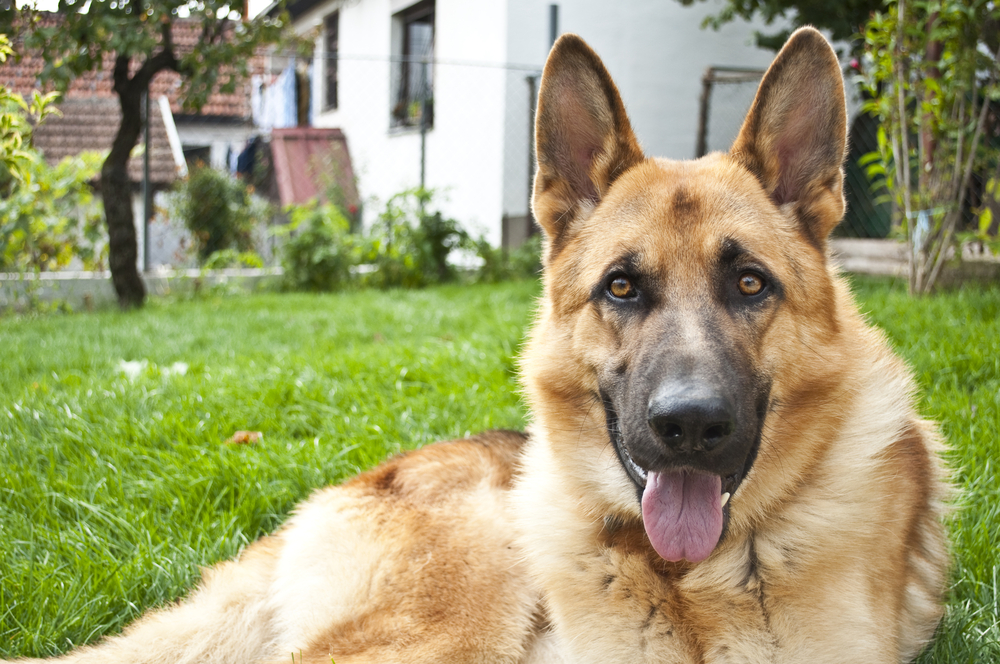
Table of Contents[Hide][Show]
Degenerative myelopathy in dogs is a heartbreaking progressive neurologic disease that attacks the spinal cord. Also known as chronic degenerative radiculomyelopathy and canine degenerative myelopathy, the disorder causes the slow breakdown of the white matter in the spine.
DM is a common cause of paralysis in large breed, older dogs between the ages of 8 – 14 years-old. Younger dogs can be affected as well, but it’s rarely seen in canines under 5-years-old.
Dogs first show signs of wobbly hind legs and loss of coordination that progresses into weakness and paralysis. It later attacks the front legs and ultimately dogs succumb from organ failure.
The life expectancy of victims is 2-3 years. Some dogs pass away sooner at 1 year and others have been known to live for 5 years. It all depends how fast the disease advances.
The goal of this article is to make you familiar with the symptoms of Degenerative Myelopathy in dogs, the DNA test, diet, treatments and good news about what you can do.
DM is close to my heart. The symptoms and the way it develops were nearly identical to the progression of the neurological disease that took my dog, Sophie. For that reason, I’ve tried to stay up-to-date about latest advances.
This post contains some affiliate links.

Ask & Discover
Get personalized content recommendations and answers drawn from our website. Simply type your question or topic of interest, and our AI assistant will help you find relevant articles, tips, and insights. You can also have a natural conversation to explore topics in more depth.
What researchers know
DM was first classified as a disease in 1973. At the time, veterinarians thought it was a condition exclusive to German shepherds and for a while it was called German Shepherd Degenerative Myelopathy. Today we know many large dog breeds are prone.
We also know the symptoms are similar to a human disease called ALS (Amyotrophic Lateral Sclerosis), or Lou Gehrig’s disease. Much of the research has revolved around this idea, trying to duplicate the treatment of ALS patients to canines.
In 2009, scientists also discovered a genetic mutation in DM victims. The cause is a DNA mutation in a specific gene called SOD1. This development led to the development of a DNA test your dog can take.
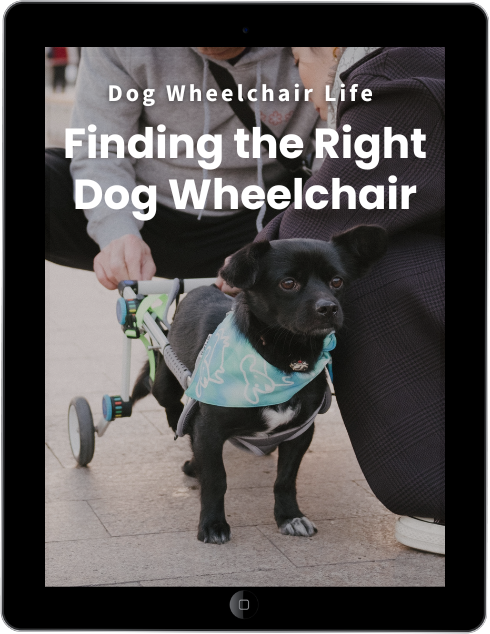
eBook
Find The Right Dog Wheelchair For Your Pet
Your dog has a mobility problem, and you want to buy a wheelchair. But do you know what kind of cart will work best for your dog’s individual needs? After a decade of teaching pet owners how to make the right choice, I put the information into an eBook!
Progression of the disease
DM slowly attacks a dog’s central nervous system by stripping away the protective coating called myelin. This leads to a breakdown of the white matter in the spine which controls movement.
As the white matter deteriorates, less commands about mobility are received from the brain to the limbs and fewer physical sensations are sent from the limbs to the brain. (I hope that makes sense.)
Dogs prone to the condition

Here’s a list of the breeds deemed susceptible by the University of Missouri. That doesn’t mean every dog will have the mutated SOD1 gene. It means these breeds have had the genetic mutation and “microscopic examination of spinal cords from deceased dogs exhibited symptoms.”
- American Eskimo Dogs
- Bernese Mountain Dogs
- Borzoi
- Boxers
- Cardigan Welsh Corgi
- Chesapeake Bay Retrievers
- German Shepherd Dog
- Golden Retriever
- Great Pyrenees
- Irish Setters
- Kerry Blue Terriers
- Pembroke Welsh Corgis
- Poodle
- Rhodesian Ridgeback
- Shetland Sheepdog
- Soft Coated Wheaton Terriers
- Wire Fox Terrier
Symptoms of Degenerative myelopathy in dogs
I’ve broken down the signs of DM into common early symptoms and advanced stages. If your dog is suspected to have Degenerative myelopathy, they won’t have every symptom listed.
Here are common early symptoms:
- Weakness in the hind limbs that gets progressively worse
- Difficulty getting up from the floor
- Wobbly legs
- Walks by swaying the hips
- Worn down nails
- Knuckles under the paws. (The medical term for this is proprioception. It happens because a dog isn’t aware or can’t feel how they’re placing their paw on the ground.)
- Dragging the back feet
- Muscle loss in the back legs
- Tremors or spasms in the hind legs
- Paralysis in the hind end

Get the Essential Guide
The Essential Guide of Products for Handicapped Dogs e-book is a labor of love for me. I wrote it to answer your most pressing questions about where to find the best products for your wheelchair dog. You’ll find products you didn’t know existed and each will improve your dog’s quality of life. Print a copy and keep it by your side.
Meet Skye
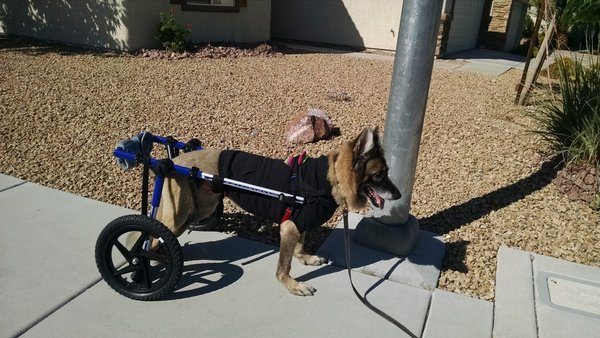
Skye was the treasured German shepherd of Dorri and Karol. I met the family when Skye had been diagnosed with DM for two years. I’ll be sharing their story throughout this post.
The first symptoms Skye showed were pretty typical for the disease.
One day, out of the blue, she stumbled down the front steps of her house. Dorri and Karol checked her for injuries, but she seemed fine. They chalked it up to the fact that Skye was becoming an old dog.
Not long after, Dorri and Karol noticed that Skye’s hind legs wobbled and crisscrossed when she walked around the house. They would get tangled and cause her to fall.
After six months Skye was paralyzed from her hind legs to the middle of her body. She was incontinent as well.
Advanced stages:
- The symptoms of weakness and knuckling move to the front limbs
- Urinary and fecal incontinence
- Muscle wasting
- Pneumonia
- Infection
- Organ failure
Most DM dogs go from being healthy to paralyzed within 6 months – 1 year from the onset of their symptoms. The advanced signs appear from 1 – 3 years, with some dogs surviving up to 5 years.
Here’s a video of a dog showing the early signs of DM. It was submitted by a devoted pet dad who wanted to help pet families.
A disease without pain
When DM starts it can resemble other conditions, like hip dysplasia, a ruptured disc, cancer or a spine infection. So, if you’re worried about getting an accurate diagnosis, here’s a clue to keep in mind.
Degenerative myelopathy is not a painful condition in the early stages. I like to think of this as an act of kindness from nature, but being pain free is an important unique aspect of the disease.
On occasion a dog can experience neuropathy as the nerves in their spine die. These pups tend to bite and chew on their paws, but they don’t show other signs of pain. If your dog experiences this problem, you can wrap the paws in gauze or add soft booties to protect them from injuries. You can also talk with your vet about medications and other treatments.
How veterinarians diagnose DM
Veterinarians make their diagnosis based on your dog’s symptoms and by ruling out other conditions, like the ones mentioned above.
The only precise way to diagnose the disease is by examining the spinal cord after an animal passes away.
If your vet suspects DM the diagnosis process will probably begin with a physical exam and a basic neurological exam. Blood work and X-rays are also routinely ordered.
Many dogs are then referred to a veterinary neurologist where they undergo a thorough neurological assessment along with a CT scan or an MRI. These powerful imaging tests examine the layers of the spine. They’re valuable tools to rule out other disorders.
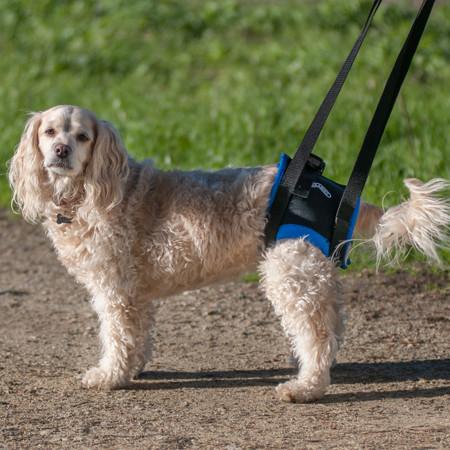
My favorite harnesses for disabled dogs.
A DNA test

The gene mutation for DM was discovered during a research study conducted by the University of Missouri. It led to the development of a DNA test which has been a big benefit to vets and pet owners.
If your veterinarian suspects DM, you’ll probably be asked to order this test for your dog. The DNA test is inexpensive and can be ordered online through the Orthopedic Foundation for Animals (OFA). It’s done in your home with an easy to use swab of your dog’s cheek. Pet owners then mail the test to OFA for the results.
The test identifies whether or not your dog has two copies of the mutated SOD1 gene associated with Degenerative myelopathy. Unfortunately, it isn’t able tell you that your dog has an active case.
The test gives pet owners the following information:
- At-Risk (A/A) – If your dog receives a test result of A/A, it means they’re in the highest risk category. It says your dog’s DNA has two mutated copies of the SOD1 gene associated with DM. If your dog is exhibiting DM symptoms, this test result will give your vet an important piece of information. On the other hand if your dog is being tested because their breed is prone, an A/A score doesn’t mean they have a 100% chance of developing the disease. Not every dog with two mutated genes will have Degenerative myelopathy during their lifetime.
- Carrier (A/N) – This test result means your dog was identified to have one mutated gene and one normal gene. Dogs in this category are less likely to develop DM, although the possibility is there.
- Normal (N/N) – Dogs in this category were identified to have two normal copies of the gene. It means your dog is unlikely to develop DM, although it doesn’t rule out the possibility completely. Two dogs in the University of Missouri study with this result, went on to develop DM. This was probably due to other risk-factors in the breed.
Physical therapy, laser therapy, holistic care and nutrition
No treatment will cure DM, but several new studies are revealing ways to prolong a dog’s life. One clinical trial published in the National Library of Medicine proved that daily physical therapy with a canine rehab specialist, increased a dog’s survival rate. A second study released in 2020 showed that Laser Therapy also prolonged the lives of DM patients.
Other methods to manage DM:
- Water therapy – DM dogs do very well with hydrotherapy. Dogs work with a canine rehab specialist in a specially designed and heated indoor swimming pool or in an underwater treadmill. Water therapy keeps the leg muscles flexible and the core strong.
- Holistic veterinary care – Chris Bessent, DVM, MSOM, Diplomat of Oriental Medicine is the founder of Herbsmith Inc. Dr. Bessent treats DM dogs with electro-acupuncture. She likes this particular form of acupuncture because it sends a warm wave of electricity to a dog’s spine. She also prescribes omega-3 oil that comes from Krill for her DM patients because it nourishes the spine.
- Good nutrition – Like people, dogs do better when they eat a “clean” diet of fresh whole foods. Even small changes can make an improvement. Ask your vet for recommendations. Dr. Clemmons, DVM, PhD has spent most of his career researching DM. He developed a diet to stabilize the immune system and eliminate toxins. You can find Dr. Clemmons homemade diet and supplement recommendations on his website.
- Maintain a normal weight – This is important to slow down inflammation.
- Make your house chemical free – Remove toxins in your home by switching to chemical free cleaning and freshening products.
- Add traction – DM dogs can lose confidence slipping on slick surfaces and as their hind end weakness progresses. By adding traction and support with a lifting harness and dog boots early in the disease will keep them walking longer.
- Dog wheelchair – Studies show that adding a cart soon after DM symptoms arise is important. It enables dogs to exercise their legs and you can use the cart for at-home physical therapy.
Skye’s rehab program
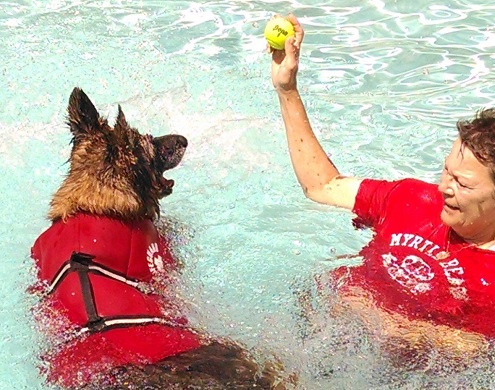
During her first year with Degenerative myelopathy Skye spent a lot of time in water therapy. It was great way to keep her muscles strong without overtaxing her body.
She loved being in the water so much her owners also took her to a friend’s house where she could splash and play in the pool.
If you choose to go this route, be sure to have a “dog swim vest” on your pet the entire time they’re in and around the water. And be sure to stay with them in the pool, at all times.
Unfortunately, accidental deaths have been reported because pet owners didn’t notice the gradual decline of their pet’s health.
Good breeding practices to prevent DM
Because Degenerative myelopathy is an inherited disease, victims can be limited through responsible breeding practices.
If you’re planning to add a puppy who’s prone to the disease, ask the breeder about the history of DM in the dog’s lineage.
Good breeders are proactive and remove a dog from the breeding pool when their DNA test shows they’re in the At-Risk category.
What you can do for your dog
DM is a sad diagnosis, but the good news is that you can make a big difference to your dog’s quality of life.
Here’s a list of activities to help:
- Take your dog for a daily walk. Dogs love the fresh air. Purchase a support harness to make walking easier and booties to protect the paws.
- Ask your vet for a hands-on lesson about how to express your dog’s bladder. Expressing is the best way to prevent urinary tract infections.
- Talk to your vet about gentle range-of-motion exercises you can do with your dog at home. In will help to maintain your dog’s muscle tone.
- Invest in a dog wheelchair or stroller or dog trailer for the time when your pet won’t be able to walk on their own. Dogs feel better when they can be mobile.
- Make sure your pup has a good orthopedic bed to prevent pressure sores.
- If your dog is immobile, be sure to gently turn your every 2-4 hours. Lying in one position for too long increases the chance for the skin to breakdown.
- Show your pup love and affection. You mean the world to them.
How Skye spent her time
Skye’s day began with a sponge bath by one of her doting owners. It kept her fur clean and free from urine that dripped overnight. Then Dorri or Karol would take her outside to express her bladder. A support harness helped them lift and move her.
After breakfast there were visits to the pool or to a holistic veterinarian for acupuncture treatments and laser therapy.
In the afternoon Skye got to do one of her favorite activities. She loved her daily walks and being outdoors. A dog wheelchair allowed her to continue this ritual as her health declined and after she could no longer walk.
Later when DM made it hard for her to sit up on her own, Skye’s family transitioned to a dog stroller/trailer. It let her enjoy the sights and scents of her neighborhood and say hi to the people on her street. Skye lived with Degenerative Myelopathy for more than 3 years.
Want to learn more about managing daily life for a DM dog?
Click here to read: Learning How To Express Your Dog’s Bladder – Urinary Incontinence

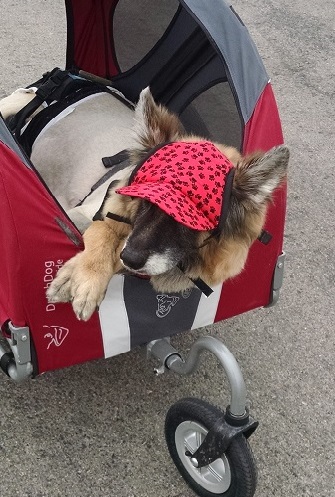
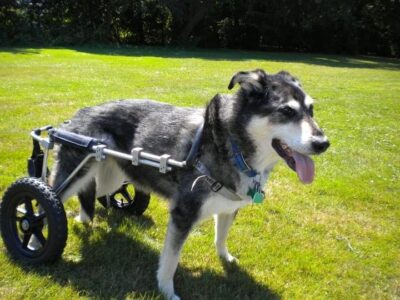


What a heartbreaking disease! Thanks for sharing all this great detail about DM and for sharing Skye’s story – what a beautiful dog.
Thank you for sharing Skye’s journey. I adopt retired K9 German Shepherds. My 1st K9 Rommel came to me after being diagnosed & retired by his Handler. We had 8 great years until the last day. (8/20/12).His successor K9 Cisco came to me at his retirement. He was recently diagnosed. (I already recognized it) I got him all of the same booties, orthopedic bed, belly lift, Walkin Wheels, & a car ramp & a ramp down the 1 step to our back acre.
He has the easy harness to clip the wheels on instead if lifting him into the Walkin Wheels. Gave both of mine their mobility, potty ability & dignity back. All terrain fun. Our field, off season beach & waters edge walks, Pet store, Feed mill trips. Car rides & ice cream, puppichinos, & Dunkin Donuts.
My dogs were K9s & show me their Dunkin Donuts
Paula, Thank you for taking care of these dogs. Senior dogs are the best. Your guys were lucky to find someone like you who understands DM and the wonderful equipment that can extend their lives.
Thank you for sharing all this information. My Roxy likely is suffering from DM. She started showing the symptoms in May and I had her DNA tested for the genetic markers in August- she is A/A so I’m confident in saying she has DM… it is heartbreaking to see a once very active dog struggle, but she is such a trooper and never gives up. She has bad days but still more good than bad. I pray they find a cure for this devastating disease. Thank you again for the information and suggestions. As long as she is still a happy girl, I can’t bear to let her go.
Paula, we have a walkin wheels but unfortunately haven’t really gotten to use it. What harness are you talking about? I’m interested in checking it out.
Hi Jo, It can take time for a dog to get used to a wheelchair so please don’t give up hope. In the meantime, if you’re considering a support harness here’s a story we have on the blog you might find helpful. It’s about the leading support harnesses for disabled dogs. Here’s the link: https://dogwheelchairlife.com/how-to-choose-the-right-support-harness-for-your-paralyzed-dog/ I hope you find it helpful.
Where can I buy a wheel chair/ harness support for my GSD , she has boots but it slowly getting worse ?
Skye, I have two stories with all of the details. The first one lists all of the major dog wheelchair companies and describes their specialties. https://dogwheelchairlife.com/dog-wheelchairs-how-to-choose-the-right-cart-for-your-pet/
A second article talks all about support harnesses: https://dogwheelchairlife.com/how-to-choose-the-right-support-harness-for-your-paralyzed-dog/
This will direct you to the products you need. For other product recommendations go to dogwheelchairlife.com and click the spyglass search icon. Type in what you need. More than likely there’s an article to help you.
Thank you so much for sharing all the information of this very sad illness, my beautiful Lucy is a rescue dog, but to tell you the truth I think she is an angel that came into our family, she is the sweetest companion you could ask for, she’s my emotional support dog and 2 days ago was diagnosed we are really heartbroken, all that we can do it’s take care of her with the same love we have always had and keep a close eye to make sure that she’s not suffering, when that day gets here I will take her my self to the vet and put her to sleep in my arms with all the love and respect that she has earned, again God bless you for the information it did really helped me to understand her condition better🙏🏻🙏🏻🙏🏻
Millie, I’m sorry you and your dog are going through this ordeal, but I love your attitude about dealing with it. Lucy is lucky to have you.
Where can I get walking wheels, could you send pic
Walkin’ Wheels is sold by Walkin’ Pets. The link to their website is: https://handicappedpets.com
Let me know if you have any questions.
-Sharon, Dog Wheelchair LIFE
Hi Paula,
Thank you for sharing your information. This is new to me and we are just in the beginning stages. We purchased walking wheels (but luckily have not had to use them yet) but I was reading in your post that you used a belly lift and an easy harness to clip the wheels.
Can you tell me what those are for and how they aided you. Anything that will help me to move him around would be great.
We actually purchased the wheels for our older Shepherd “Cam” (11) as his hind end is very weak and we knew it wouldn’t be too long before he may need it and we wanted to be prepared. Unfortunately we just found out our 8 year old Shepherd “Attila” has DM.
So finding ways to keep these guys mobile is very important to me, I’m a pretty small woman so carrying them is not an option. 🙂
Thank you for any help!!
Denise
Hi Denise, The clip in harness Paula mentioned is called the Warrior Harness. Pet owners love it because it’s easy to use. Put the harness on your dog and then clip the Walkin’ Wheels cart into it. You can find more information about the Warrior Harness here: https://www.handicappedpets.com/walkin-warrior-front-harness/ Best wishes, Sharon
This is the best information and our buddy boy hasn’t been officially diagnosed with this but he checks every box except no bathroom issues yet….unfortunately I work all day and unable to give him all the extras some of these owners have noted in comments…it hurts my heart to see him struggle more and more each day
If any of your readers have dogs they feel may have DM or wish to learn more about it, they are welcome to also join the https://www.facebook.com/groups/DMDogs/ over 12,000 members worldwide, it is the largest DM support and education group with lots of friendly people who have been through or who are going through this insidious disease
Thank you for sharing this information. I’m a fan of Cure 4 DM and all you do for dogs with Degenerative Myelopathy. I hope you’ll share Dog Wheelchair Life with you members as well.
My Berner was diagnosed with it last summer. She will be 13 in April… To say it is a devastating diagnosis is beyond words.
Kathryn, I’m sorry you are going through this ordeal. DM is a tough disease. Please let us know if you have any questions.
My 197lb white german shepherd was diagnosed with hip dysplasia 2 yrs ago. He’s overweight. Symptoms returned. Main concern is he can’t walk to use bathroom out side. 2 heavy to lift even on blanket carry as he quickly sits up and backs up off it. Will my dog urine and release his poop on his own in the spot he’s at? I’m very worried. I’m giving him extend for dogs joints and aspirin as well as glucosamine. He still whines and softly barks all night. I’m at a loss. I don’t know what to do. Please help me with any advice possible as my dog is all I have.
I’m sorry to hear about your dog. The short answer to your question is yes, your dog will pee and poop if you don’t move him outside. Lay out pee pads all around him to catch some of the mess. You can also try a dog diaper. Another technique to move your dog is to use a large towel as a sling. Run it under his belly and hold the ends with your hands, as handles, to you can move him. He’ll feel better about standing upright instead of on a blanket. Please take a look on our site, under Daily Care. You’ll find lots of suggestions to help. Best to you and your shepherd.
You did a lot of research and a great job on your web site. My Boudreux passed of this disease too.
I saw your site from the facebook #shade out DM.
here is his story if you wish to share.
https://www.youtube.com/watch?v=cwgSNQpsDU0&list=FLINKyeau30wA8KXyXsn6sCg&index=18
Denise, Thank you for sharing your dog’s story. I’m sorry for your loss. DM is a heartbreaking disease.
Thank you so much for this information. We noticed our pups hind legs seemed weak and off balance a few months ago and we are pretty certain he has DM after reading through this. He is definitely in absolutely no pain, in fact I kept saying how strange it seemed that he was falling off balance but seemed unaware and with no pain. The Vet had mentioned possible DM but she was ruling out other things first by trying a pain and anti inflammatory medication first, and no difference (again no pain but just in case he wasn’t showing it). I’m ordering the DNA test now as part of the process. Again, thank you for putting all of the right information in one place.
Danielle, I’m glad you found the story helpful. If you find out that your dog has DM, I hope you’ll join the Dog Wheelchair LIFE FB group. We have lots of members who can help make the transition to life with a disabled dog easier.
My boxer has dm its very heart breaking hes such a good boy..Hes lost use of back legs but can set up..Getting him to go to the bathroom can be a battle..What does the term express his bladder mean? Want to make his life as best as it can be..
Richard, I’m sorry about your boxer. The term express a bladder means that you manually push on the bladder with your hands to help your dog release it. There are many techniques. Dogs with DM are prone to urinary tract infections because they can’t release urine or they can’t fully empty their bladder. I’m attaching a link to a video, but the best way to learn is through your vet. Ask for a hands-on lesson. It takes practice, but it’s worth the effort. Here’s the link: https://www.youtube.com/watch?v=JG6ILEcJl9E&t=24s&ab_channel=Petrescuemomma
Thank you for this information. Our 13-year old JR Terrier has been showing more and more signs of DM, along with sun-downer syndrome from what we (and our believe) is probably canine cognitive dysfunction. Most recently his back nails have begun to bleed – from uneven walking/scraping. He loves his daily walks, but I’m feeling we now need to rest him for a few days every now and then. Can someone please send a link to any recommended booties or beds?
We just purchased a back walking harness, so I hope this helps. He is absolutely the same loving dog – happy, wants to play, eats/drinks, etc. He has had a couple of accidents – not making it outside in time. I’m so worried about his progression and how to make him most comfortable. Thank you all for sharing your stories.
Dawn, I’m sorry to hear about your dog. Boots are a good way to protect your boy’s paws. I’m a fan of Walkaboots from walkaboutharnesses.com They even sell a “lid” where a second sole attaches to the top of the boot for added protection if your dog knuckles their paws. And they have a new boot called Toes Up that prevents dogs from knuckling. I’m also attaching a link to a story we just posted about orthopedic dog beds. I hope you find it helpful. https://dogwheelchairlife.com/best-choice-in-orthopedic-dog-beds-for-senior-pets/ Best wishes, Sharon
Thank you so much! Just ordered a pair of Toes Up!
Please let me know what you think about them.
Hi Sharon,
Thank you for this information. My mixed breed ( we think cajun squirrel dog and Rhodesian ridgeback mix) 12.5 y/o boy, Leonard B., is suspected of having DM. Genetic markers did not show him to have this disease but everything else points to it. Veterinarian’s suspect this over IVDD as he is not in any pain, and all medication therapies did was make him pee and be more “dippy in his hippies” if you will…He is wobbly, crosses his hind legs when he walks, gets the “german Shepard dip” when standing in the backyard and is having issues with holding his bowels. We have not progressed to bladder issues, yet. But we know they are coming. What suggestions do you have for him in the bowel incontinent area? We still have accidents during the night, despite having walked him moments before bedtime. There seems to be a disconnect from his brain to his bowels telling him its “time to poop now”. At 80lbs, is a doggie diaper really the answer?
Next question is about ramps/stairs, home mobility devices…Lenny currently has a “help em up” harness https://helpemup.com/ and booties. We would like to get him a ramp or stairs so he can get on the big bed but are having trouble finding one that will support his weight. He does sleep on a big barker bed for comfort…https://bigbarker.com/ but would like to have him on the big bed some nights. Do you have any more suggestions here? I know you have links to FB, we are not FBers so…any other links are greatly appreciated!
Lastly, Thank you for this blog, it has calmed my fears about the progression of this degenerative disease. Thank goodness I work from home and can monitor my sweet old boy basically 24/7.
Take care Ms. Sharon, Thank you again
~Whit and Lenny B.
Hi Whit, I have lots of links to share with you and Lenny. (I love your dog’s name.) First, here’s a post I have about ramps. https://dogwheelchairlife.com/dog-ramps-best-choices-for-indoor-and-outdoor-use/ You’re right that most indoor ramps are for small dogs, but there are suggestions if you also want a ramp to get your dog in and out of the car. That said, if your dog has DM, the paralysis will be progressive, so look for a ramp that’s wide enough for a dog wheelchair. My dog weighed 50lbs and honestly I used the Walkabout Back End harness to get her in and out of the car. And the Help ‘Em Up harness you have is great for large dogs. Regarding the fecal incontinence, it’s normal for the disease. And most pet owners don’t put their dog in a diaper for it, unless your dog has diarrhea. Instead, I kept Sophie on a washable bed at night or when I had to be away (or you can use a crate) and just scooped up any droppings. The more your dog is in a diaper the greater chance for an infection to brew. The best technique is to express Lenny’s bladder 4 X a day and scoop up poop…. and plan on giving a quick midnight shower from time to time if he happens to to make a mess. The accidents your dog is having during the night, could be a sign that his bladder isn’t able to fully empty without help. If you’re expressing it, be sure it’s fully emptied and if you use diapers, you might need to learn how to manually express. https://dogwheelchairlife.com/learning-how-to-express-your-dogs-bladder/ Here’s another link about therapies for DMhttps://dogwheelchairlife.com/category/degenerative-myelopathy/ And last, please talk with your vet about getting Lenny into a rehab program and other therapies. Dogs who receive Laser therapy and PT or hydrotherapy, live longer. Hope this helps. Lenny is lucky to have you. -Sharon
I’m beginning to suspect that our sweet lovable pittie mix (12 years old, female brown/black brindle) might have DM as I’ve been seeing a pronounced wobbly gait in her hind legs and frequent urinary and fecal incontinence. Also been noticing that she doesn’t seem to squat at all when going outside to use the bathroom and actually a couple nights ago had to clean her off when she pooped all over her tail and hind legs. Currently she’s taking an antibiotic for a UTI (which I hear can also be common in DM as the urine instead just trickles out randomly). Should probably mention the ataxia and the frequent incontinence despite being on the antibiotic for going on day 4 of 14 at the follow-up. We got our sweet lovable Ginger girl when she was a little over a year old back in 2010. She’s been such a wonderful and loving dog to us. Comforted us through the loss of many loved ones, both furry and human (she replaced our second dog who died on her own at the ripe old age of 17 and comforted us through the loss of our second cat at the ripe old age of 19 about 4 years ago and also comforted us through the loss of my dad to cancer a couple months after we got her and also through the loss of both my godfather and my last grandparent). If DM is what the vet says then it will be heartbreaking as we’ll probably have to euthanize her. We unfortunately cannot afford any of the assistive devices mentioned and while my sister’s work schedule is fairly consistent mine and my mom’s are not so setting up a bladder expressing schedule won’t be too feasible either. She loved us so much and we loved her in turn and she’ll be our last dog as we look at transitioning to apartment life upon her death, whenever that may be (still holding out hope that my instincts are wrong here and currently blubbering on and off at the prospect).
Joseph, I’m so sorry to hear about your dog. It sounds like she’s been the light of your life for a long time. If she does have DM, her symptoms will progress, but there are ways to make her more comfortable now. Here’s a link to stories on the website for dogs with DM: https://dogwheelchairlife.com/category/degenerative-myelopathy/ If you choose to get a dog wheelchair there are lots of nonprofit groups to help you. https://dogwheelchairlife.com/organizations-that-donate-dog-wheelchairs-to-pet-families/
And in the meantime, you can make her more mobile by using a large towel as a sling. Fold a large towel in half (the long way), put it under her belly and use each end as a handle for you to hold. You could also ask your vet for a hands on lesson about manually expressing her bladder. It doesn’t sound like she can do that on her own anymore. I hope some of this information helps. And when it comes time to say goodbye, I’m sure your girl will know she is deeply loved. – Sharon
When I got back from work tonight my mom said she just laid in the same spot all day (probably out of reluctance to get up due to the difficulty walking) and she actually hasn’t been moving her tail either from what I’ve seen the last few days when usually you give her a belly rub and tell her you love her that tail starts going a mile a minute. Probably humane to euthanize her at this point before it gets into the front limbs and internal organs.
Hello, my now 10 year old Belgian Malinois is going on his 3rd year with this horrible disease. Jagger was verified with DM by a MRI in March 2018. I’m devastated. He can’t support himself anymore. He can’t stand. I have to bring him water and food to him and hold him with a support harness to let him urinate. His mind is happy, but he can’t get up any longer. I’m afraid he’s deteriorating very quickly. I bought a class 3 laser, did laser therapy, I did acupuncture on him and fed him a raw diet. I have done EVERYTHING in my power for him. I don’t know when is the right time to put him down. I don’t think he’s in pain, but I don’t want him to be in pain. This is so hard. Bless all the owners out there who are going through this and doing everything in their power to help their pets. Their dogs are so lucky to have them. Please keep my boy Jagger in your thoughts. I know one day he will be running happy in free in heaven…just making the decision is so hard because his mind is fine and he seems happy.
Donna, I’m so sorry you and Jagger are going through this ordeal. Degenerative Myelopathy is a heartbreaking disease. It sounds like you’ve done a good job taking care of him. Not many DM dogs live with the disease for 3 years. There are no set guidelines about when it’s time to say goodbye, but a wonderful animal hospice company called Lap of Love put together a way to assess the situation. You can read about it and download the questionnaire here: https://dogwheelchairlife.com/dog-euthanasia-making-the-decision-to-let-your-pet-go/
I hope you find it helpful. – Sharon
I just read your article and found it very interesting. We have a problem with our little Cavalier King Charles Spaniel. He is only 14 months old and just discovered that he has Calcification of the spine. He started lifting his left back leg when he got up for about 30 seconds and then he would be fine for a while it was like his leg went a bit numb from maybe laying on it. All this started about when he was 7 months old when he was about 12 months old I noticed he was walking funny like his right back leg was all wobbly. We went to the vet he took X-rays and that didn’t show much. He sent us to the Animal Hospital and he had a CTscan and a MRI and it shows he has Calcification of the spine.
Hi Janina, I’m sorry to hear about your dog. I’m not a veterinarian, but this is what I know about Cavalier King Charles Spaniels. They are prone to a condition called Syringomyelia and one of the symptoms is calcification on the spine. Cavaliers have a particularly small skull size which can cause fluids that remove toxins from the brain and spinal cord to build up. Here’s the link to an article I have on my website: https://dogwheelchairlife.com/syringomyelia-in-dogs-targets-specific-breeds/
Your dog’s symptoms might be calcification, but the underlying problem could be Syringomyelia. Again, I’m a pet mom and not a vet, but this is something to discuss with your vet or the specialty hospital you went to. Best, Sharon
This was great, I have been researching for a while now, and I think this has helped. Have you ever come across Health Herbs Clinic com Amyotrophic Lateral Sclerosis HERBAL FORMULA (just google it). It is a smashing one of a kind product for reversing ALS completely. Ive heard some decent things about it and my buddy got amazing success with it.
My son’s service dog (Great Pyrenees 8.5yrs old) just got diagnosed with DM and we are still processing it honestly. The last 4 months we went from some mild arthritis to the start of neuro symptoms so they did an mri where they found 3 compressed discs which we started steroids for a week later we are now showing DM signs. He’s already doing acupuncture each week and will start water therapy next week. My son (17) told the doctor that we are going to do what his dog needs to have best quality of life but not something that would only be for himself (meaning my son) as that isn’t fair to the dog… now us just hoping that the interventions help slow this terrible disease down
We heard supplements may help. Anyone have any luck with any? He already gets NuVet joint every day.
Thank you
LisaBeth,
I’m sorry to hear about your son’s dog. A recent study for DM dogs showed that adding laser therapy to their physical therapy or hydrotherapy routine slowed the disease process.
Here’s the link to the article – https://dogwheelchairlife.com/laser-therapy-prolongs-the-lives-of-degenerative-myelopathy-dogs/ Best wishes.
Hello. My German Shepherd is almost 10 years next month. About a year ago when we went for walks, I noticed every once in a while he would like trip over his back right foot. I thought it was just the sidewalk or who knows what…just getting older. I recently noticed the draggin is getting worse as now you can hear it when he walks on the wood floors. Took him to the vet. They did XRAys of the spine, hips, hind legs…he showed signs of osteoarthritis and although the degenerative change is present at multiple levels of the spine, the radiologist did not believe this would be the reason. So the vet ordered a DNA test and he came out possitve for 2 strands of the mutation. The vet indicated that although that might be the problem, there was always a possibility it could be something else. So referred us to a neurologist at University of Missouri. This place leads a research on DM and has the equipment for Scans, MRIs and other tests. We are heading out there next monday and it will be a 2 days appointment. First day to diagnose, second day to run tests. I am already nervous about the cost of the tests (as I was told would be around the $3,000 or $4,000), but despite that…I feel I need to give my Tucker an opportunity and pray hard that it is not DM but something else that is treatable. NEvertheless, I am preparing myself for the worst as years ago I lost a GS that was 8 years old to this disease. It is heartbreaking and I cry all day because neither of them deserved this. I will be interested in keeping contact here with others as the disease progresses and see how I can support him, Breaks my heart and I cannot just let him go until there is no more options. My best friend has the brother of one of my GS and he already has the DM. Both back legs paralized and cannot get up without help. I gave her a harness I had, but I think he is at the stage where he needs the wheels. My question is…dogs walk around the house and lay down very often. How do you manage having to take the wheels on and off 100 times a day ????? Like every time he wants to lay and the next minute he wants to get up…..
Flora, I’m sorry you are going through this ordeal with a second dog. DM is tough. I also suggest that you join the Dog Wheelchair LIFE Group on Facebook. It’s a great way to stay in touch with other pet parents. Your question about how long a dog should be in a cart is important. Most dogs should be in their wheelchair for exercise and walks. Wheelchairs are wonderful, but they place extra stress on a dog’s front legs and this can be especially difficult for DM dogs. For a 100 pound dog, you might have to help him up with a support harnesses (check out Walkabout Harnesses and Help’Em Up) But more than likely once you get into a routine, you’ll be fine. There’s a video on the Dog Wheelchair Life Group on Facebook that a member shared of how she lifts and helps her large dog in and out of a cart by herself. I think you’ll find it helpful. Best, Sharon
Hi,
Our just 7 year old German shepherd was diagnosed with probable DM.
We did a dna test which came back as 2 clear genes. An X-ray was done but all they could find was something called bridging spondylosis. He crosses his back legs(mainly the left) so the vet says the spondylosis could possibly cause that and has given him gabapentin but is still pretty sure it’s DM. I’ve heard this is still possible with 2 clear genes but wondered what the chances were?
Susan, I’m sorry to hear about your dog. I agree with your vet that it’s likely your shepherd is has the early signs of DM, especially with the DNA results and the symptoms of crossing his hind legs. Spondylosis is typically a minor condition that only needs attention if it’s pressing on the nerves. The only way to confirm a diagnosis of DM is with a necropsy (like a human autopsy) after death. The good news is dogs with DM are living longer and better with laser therapy and physical therapy. Here’s a link to an article: https://dogwheelchairlife.com/laser-therapy-prolongs-the-lives-of-degenerative-myelopathy-dogs/ Take a look at Degenerative Myelopathy tab on my site and you’ll find more articles to help. There’s even a story from a researcher about the best nutrition for DM dogs. Let me know if you have any questions – Sharon